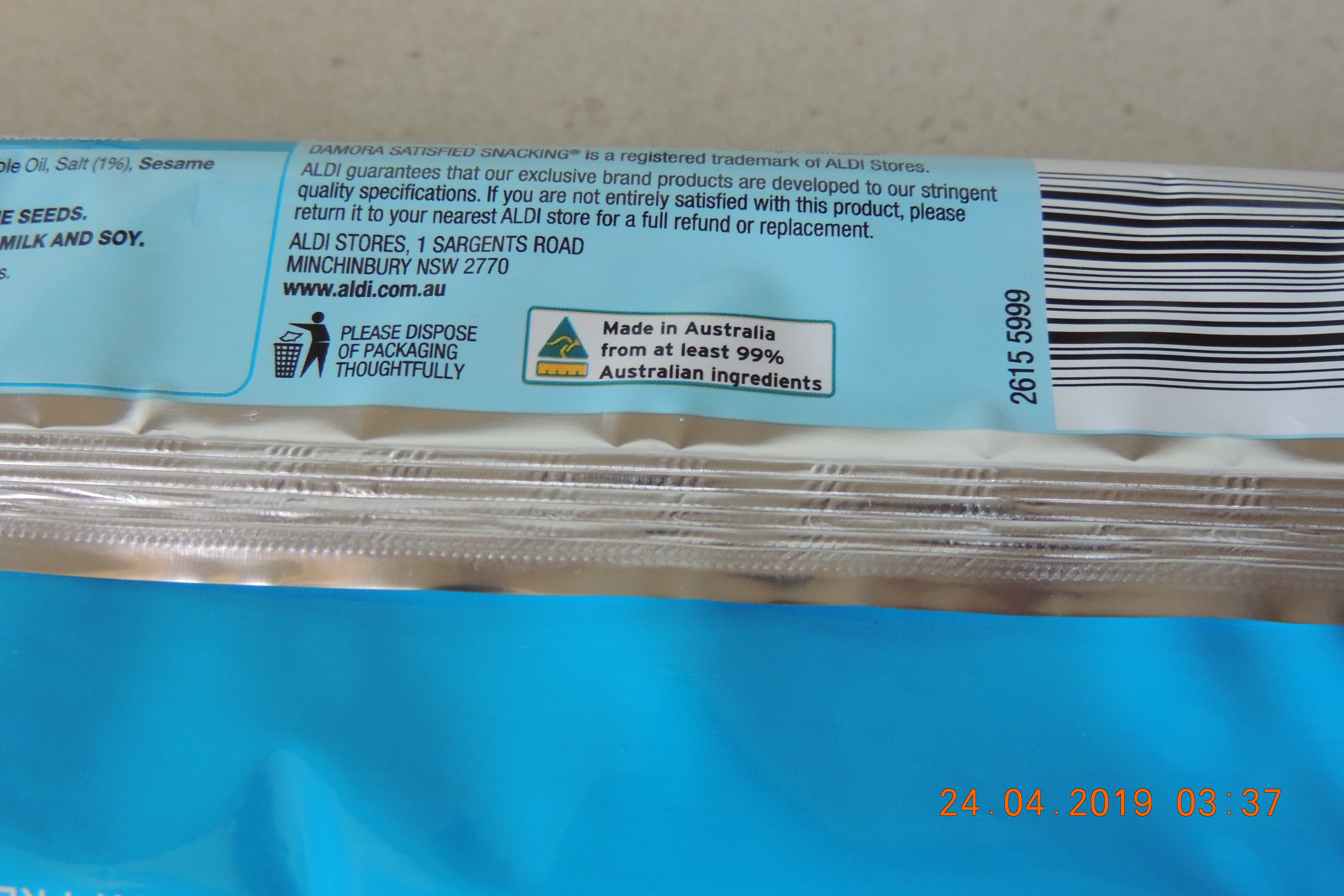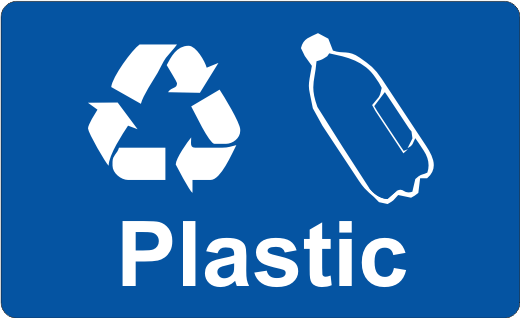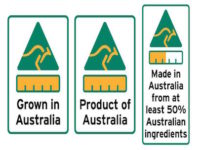41 new food labels australia
Pregnancy warning labels downloadable files - Food Standards Jul 31, 2020 · New requirements for mandatory pregnancy warning labels on packaged alcoholic beverages were gazetted in the Australia New Zealand Food Standards Code (the Code) on 31 July 2020. Businesses have three years from 31 July 2020 to implement these requirements. Current food recalls Australia's safe food system . Australian Public Service employee census 2021. Committees and groups. Feedback and complaints. Food enforcement contacts . Food law and treaties. Information Publication Scheme. Measuring Up. Modernisation of food regulation. Our role in supporting nutrition-related public health . Service Charter. Stakeholder ...
New Food Labelling Laws Begin July 1 Businesses selling food in Australian retail stores, markets, online or in vending machines will need to apply the new food labels from July 1. However, it doesn't apply to those selling food for immediate consumption such as restaurants, cafes, take-away shops, schools, caterers, prisons and fundraising events.
New food labels australia
Food Labelling & Allergen Guide - Australian Food and Grocery Council It was first development by the AFGC in 2007 but an updated edition was jointly published by the AFGC and Allergen Bureau in April 2021. New to the Guide in 2021 are: Managing and communicating changes to the allergen status of a packaged food Differentiating similar products with differing allergen content P1044 - Plain English Allergen Labelling - Food Standards The Australia New Zealand Food Standards Code (the Code) requires these to be declared on labels when they are present in food. On 25 February 2021 the Code was amended to introduce new requirements for the labelling of allergens in food. These requirements include that allergen information is to be declared: Food labelling | NSW Food Authority New requirements for labelling the most common allergens in food commenced on 25 February 2021. The changes to the Food Standards Code will help people find allergen information on food labels more quickly and easily, so they can make informed and safe food choices. For more information see Changes to allergen labelling .
New food labels australia. Labelling - Food Standards Food labels also help to protect public health and safety by displaying information such as use by dates, ingredients, certain allergens, instructions for storage and preparation, and advisory and warning statements. FSANZ sets standards for what information must be on food labels. FSANZ has developed information on a range of labelling topics. How to understand food labels - Eat For Health More information about food labelling requirements can be found at Food Labels - What do they mean? Food Standards Australia and New Zealand [PDF, 1MB]. While food labels can carry many different types of information, the main things to look at when choosing healthy food are the Nutrition Information Panel. Nutrition Information Panel Commercial Scales & Packaging Equipment [Wedderburn AU] Custom Labels Custom product labels are an effective way to achieve brand recognition, product appeal and meet your regulatory requirements regardless of whether they are food packaging labels… Compostable Labels BioLabels are available exclusively through Wedderburn. Both the material and the facestock are compostable, certified to EN13432. Australia - Labeling/Marking Requirements The joint Australia New Zealand Food Standards Code requires all packaged food to be labeled with nutritional information on how much fat, protein, energy, carbohydrates, and salt is in the product. Labels must also show the percentage of key ingredients and all the main ingredients that may cause allergies.
Food labelling - WA Health, Government of Western Australia Food labelling. Food labels provide a wide range of information to help consumers make food choices. Food Standards Australia New Zealand sets food labelling requirements in the Food Standards Code (external site) . These Labelling Standards are enforced by local government Environmental Health Officers. The Food Standards Code includes: Food labelling and imported food | business.gov.au All foods, other than non-priority foods, must carry the new labels. Non-priority foods are still required to have the country of origin statement, but the statement does not need to be placed within a clearly defined box. Non-priority food are: seasonings confectionery biscuits and snack foods bottled water sports drinks and soft drinks Changes to allergen labelling | NSW Food Authority New requirements for labelling the most common allergens in food commenced on 25 February 2021. The changes to the Food Standards Code will help people find allergen information on food labels more quickly and easily, so they can make informed and safe food choices. The changes include: Australia's new compulsory food labelling laws begin from July 1 Australians will now have a better idea about where their food is grown and made after tough new labelling became law on July 1. The new labels tell buyers what is 100 per cent grown in Australia or made in Australia from Australian ingredients, or if only the processing is done in Australia.
Develop your own label. - Correct Food Systems Australia recently adjusted their Allergen Labelling requirements. See Webpage Plain English Allergen Labelling The common food allergens and sulphite preservatives must be listed in the ingredients list, or in a separate statement on or near the food. Food Standards Australia New Zealand considers nutrition ... May 02, 2022 · Lifestyle Drink Retail Food News TAS News Health & Wellbeing Australia Fitness Food Standards Australia New Zealand considers nutrition labels for alcohol Melissa Iaria NCA NewsWire Private Label Foods - We Bring Products To Life The team at Private label foods not only helped us bring our vision to life they provided us with solutions to problems that all new business owners face. Their flexibility and agility to work with us when we were small but ability to continually scale with us as we grow has been the key to making our business a success." Food labelling - health.vic Food labelling Key messages All packaged foods sold in Australia must comply with the labelling requirements of the Australia New Zealand Food Standards Code, which applies in Victoria through the Food Act 1984. Food labels must carry essential information, so that consumers are informed of the nature and properties of foods before they buy.
Food labels - Better Health Channel Food labels carry useful information to help you make informed choices about what you and your family eat and drink. Most packaged foods are required to have a label with this information, but the information required depends on the food type. ... Food Standards Australia New Zealand (FSANZ) Tel. (02) 6271 2222 ;
PDF Australian Made, Australian Grown Logo The Logo & Food Labelling Under the new scheme, most food products grown, produced or made in Australia will be required to carry a new country of origin mark, comprising three elements: 1the kangaroo logo 2 a bar chart showing the percentage of Australian content (by ingoing weight) 3a text statement
Country of origin food labels | Department of Industry, Science, Energy ... The current requirements for country of origin labelling for food came into full-effect in July 2018. We reviewed the reforms in 2021. The review examined how well the reforms: improved consumer access to information about the origin of food clarified the origin claims businesses can make about their products

Design Institute of Australia (DIA) - Are you up to date with the new Australian food labelling ...
Food energy - Wikipedia Many governments require food manufacturers to label the energy content of their products, to help consumers control their energy intake. To facilitate evaluation by consumers, food energy values (and other nutritional properties) in package labels or tables are often quoted for convenient amounts of the food, rather than per gram or kilogram; such as in "calories per serving" or "kcal per 100 ...
Food labelling FAQs | ACCC The Country of Origin Food Labelling Information Standard (Standard) commenced on 1 July 2016. The Standard establishes a new system for the country of origin labelling of food products sold in Australia. Businesses have up to two years to transition to the labelling requirements set out in the Standard. During the transition period, businesses ...
Food Labelling - Day Dots & Kitchen Labels | Nisbets Australia New to our website. Register with us for even better deals plus access to view orders, retrieve saved baskets, manage invoices and more. ... With food labels, you'll know exactly when your food or ingredients were prepared, ... NSW 2560, Australia Tel: 1300 225 960. Email: [email protected] Change Country ...
Labelling laws | NSW Food Authority * Food labels are legally required to show the name and Australian or New Zealand business address of the manufacturer or supplier (packer or vendor importer) plus the lot and batch number of the food (or date coding) to enable efficient food recalls. Food is recalled when it poses a possible public health and safety risk to consumers.

**AUSTRALIAN MADE! New food labels finally here! BUT not Mandatory until 30/06/2018!** - Food ...
Labelling - Food Standards The Food Standards Code includes the general labelling and information requirements (Chapter 1 of the Code) that are relevant to all foods, and sets out which requirements apply in different situations (for example food for retail sale, food for catering purposes, or an intra-company transfer).
Grown in Australia? New food labelling system offers the answers Australian consumers will have more information about whether their food is grown or produced in the country after a new food labelling system comes into effect on Sunday. From 1 July,...
Label your products | business.gov.au A range of food labelling requirements are also set out under the Australia New Zealand Food Standards Code, including for: use by and best before dates ingredients, food additives and allergens nutrition information health advice and claims the supplier's name and address. Find information on food labelling requirements in the Food Standards Code.
Ingredient lists and percentage labelling - Food Standards Percentage labelling Most packaged foods have to carry labels which show the percentage of the key or characterising ingredients or components in the food. This allows you to compare similar products. The characterising ingredient for strawberry yoghurt would be strawberries and the label would say, for example, 9% strawberries.
Food Standards Australia New Zealand considers nutrition ... May 02, 2022 · Food Standards Australia New Zealand (FSANZ) announced on Monday that it was preparing a proposal to consider including energy labels on alcoholic drinks. Unlike most other packaged food and drinks, packaged alcoholic beverages have been exempt from providing nutrition information on the label.
new_food_labels.jpg | IP Australia Blog. Official Notices. System availability. IP rights search. Patents search (AusPat) Australian Trade mark search. Australian Design Search. Plant breeder's rights search.
Government's proposed new food labelling system to incorporate Australian Made, Australian Grown ...
Nutrition information panels - Food Standards Nutrition information panels (NIP) on food labels provide information on the average quantity of energy in kilojoules or in kilojoules and kilocalories and these nutrients: protein fat saturated fat carbohydrate sugars sodium - a component of salt. A NIP will include information about other nutrients if a claim is made.
Food Safety Labels and Food Safety Solutions | Fildes Food Safety Fildes Food Safety is Australia’s leading supplier of high-quality food safety products, resources and commercial kitchen supplies. Fildes Food Safety supplies a wide range of food labels, commercial kitchen supplies and personal protective equipment to the hospitality, healthcare and education industries.
Farmers hope new food labelling laws spur consumers to buy more ... After a two-year phase-in period, new country-of-origin food labelling laws come into full effect in July. An example of the new labelling system that is now compulsory. (Supplied) The labels clearly spell out where food is from, and which foods are grown, produced or made in Australia. All priority foods must display new country-of-origin labels.









Post a Comment for "41 new food labels australia"